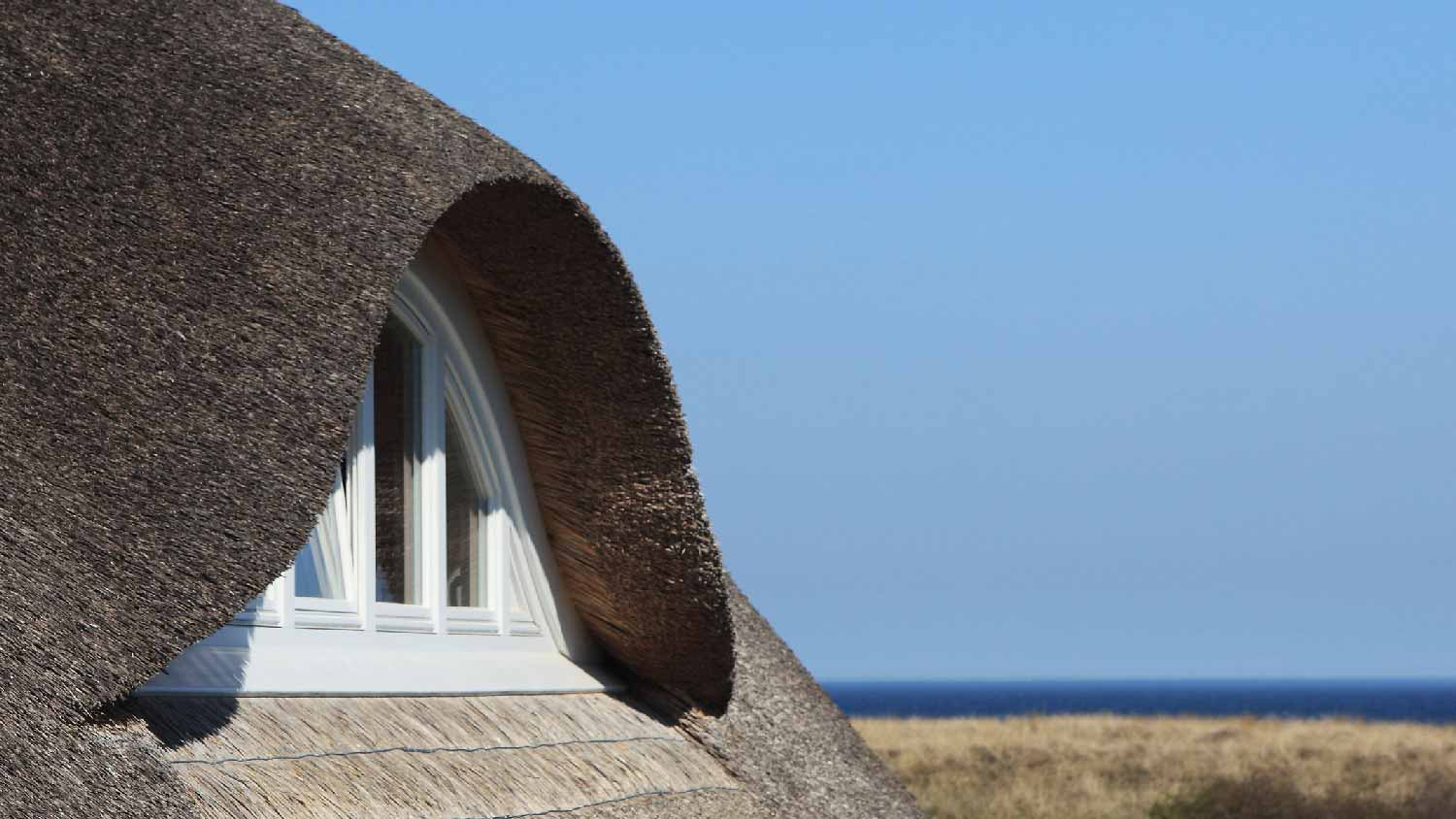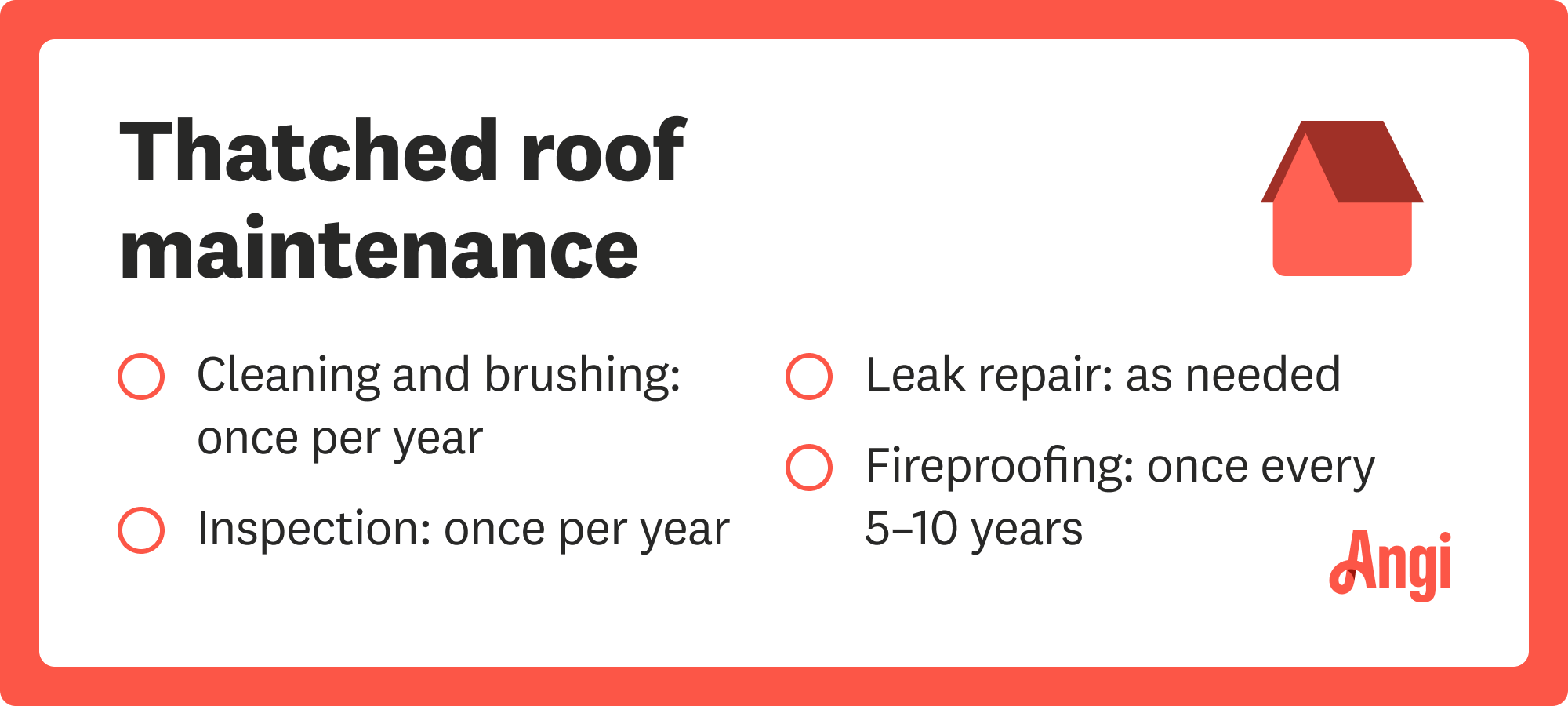
A new metal roof can add a unique touch to your home’s curb appeal and help maximize efficiency. Learn about metal roof costs and what affects your total.
A thatched roof costs around $40,000, on average. Most people spend between $30,000 and $55,000, depending on square footage, roof slope, and other factors.


A thatched roof costs an average of $27,000 to $54,000 for a 1,500-square-foot home.
On average, labor accounts for 50% to 70% of the total.
Common thatch materials are long straw, combed wheat straw, and water reed, which cost an average of $2,000 to $2,500 per square.
Thatched roofs should be cleaned at least once per year, which costs an average of $600 if you pay a pro to do it.
Thatched roofs cost around $40,000, on average, but you could spend anywhere from $18,000 to $110,000, depending on a few factors. Thatched roofs are uncommon in the U.S., partly because the materials are difficult to source, and most roofers don’t have the experience necessary to install them.
However, they add a ton of charm to your cottage home and naturally keep your living space cool in the summer and warm in the winter.
In this guide, we’ll discuss thatched roof costs, the factors that influence your total price, and how to save money in the process.
Thatched roofs can cost anywhere from $18,000 up to around $110,000. Prices vary so widely because of a few key factors influencing the total.
As is the case with any type of roof, the square footage of your home is a major factor when it comes to the cost of a thatched roof.
Most roofers charge by the roof square—called a thatcher’s square in some cases for thatched roofs—a section of 10 feet by 10 feet, or 100 square feet. In most cases, the cost of a thatched roof square falls between $1,500 and $3,000. The larger your roof is, the more materials and labor you’ll need, and the higher your price will climb.
The table below includes average thatched roof costs based on home square footage. These numbers assume you have an average roof pitch of 6/12, which means the roof slopes up 6 inches for every 12 inches of run and has 1-foot overhangs for your eaves.
| Home Size (sq. ft.) | Thatched Roof Cost |
|---|---|
| 1,000 | $18,000-$36,000 |
| 1,500 | $27,000-$54,000 |
| 2,000 | $36,000-$72,000 |
| 2,500 | $45,000-$90,000 |
| 3,000 | $54,000-$108,000 |
The steeper the roof pitch gets, the more roofing squares you’ll need to cover your roof, even if your home square footage remains the same. Additionally, steeper roofs are more challenging to walk on and require more safety equipment, which can increase labor costs.
The following table includes average thatched roof costs for a standard 2,000-square-foot home with varying roof pitches for comparison. You can calculate your roof pitch to get a better estimate for your home, or you can have your roofing professional get an accurate measurement and roof cost.
| Roof Pitch | Thatched Roof Cost |
|---|---|
| 4/12 (low) | $52,000 |
| 5/12 | $54,000 |
| 6/12 (average) | $56,000 |
| 7/12 | $58,000 |
| 8/12 (steep) | $60,000 |
| 10/12 | $64,000 |
| 12/12 (very steep) | $70,000 |

More complex roof designs will increase labor costs when installing a thatched roof, as working around chimneys, dormers, utility outlets, and other obstructions will take your roofer more time and effort.
If your home has multiple stories, your labor costs will increase because your roofing contractor will need to spend more time carrying materials up and down longer ladders. They’ll also often need additional safety equipment to keep themselves safe.
Depending on where you live, you’ll have a few options for your home’s thatch material—the types available can affect your pricing. The most common options are long straw, combed wheat straw, and water reed.
The materials for this roofing alternative can vary in price depending on your location and how readily available they are. Labor costs also vary between material options, as some materials are easier to lay and cut than others, which brings down labor costs.
| Thatch Material | Avg Cost Per Square |
|---|---|
| Long straw | $2,000 |
| Combed wheat straw | $2,300 |
| Water reed | $2,500 |
Your location plays a significant role in thatched roof costs, both because materials will vary based on local availability and because of major differences in the cost and availability of labor.
Thatched roofs are uncommon in the U.S., and they require highly specialized roofers to install them properly. Depending on where you live, you may have few or no options for roofing specialists who have the necessary experience to install a thatched roof. The low availability of qualified roofers means you’ll pay a premium if you can even find a professional who can tackle the installation.
Installing a thatched roof is very labor-intensive. Roofers must prepare the thatch material, assemble eave wads, tie them together, and attach them to the rafters. In many cases, finishing a thatched roof requires cutting the thatch material to make it look uniform and tidy.
On average, labor will often account for between 50% and 70% of the total, or between $20,000 and $30,000.
Most roof projects will require building permits, which cost between $250 and $500 in most cases. The price can vary based on how your building department charges for the permits. In some cases, permit costs can rise above $500 for larger roofing jobs if your building department charges based on the project cost.

Thatched roofs are not only more expensive upfront than standard asphalt roofs, but they also come with ongoing repair and maintenance expenses that you should consider.

Thatch material can quickly accrue debris and grow mold and algae that can compromise the roof structure. You should clean or brush your thatched roof at least once annually—twice per year if you can. If you pay a professional for this service, you can expect to spend an average of around $600, but prices can fall anywhere from $300 to $1,000 or more.
You’ll also need to schedule annual roof inspections to make sure your roof isn’t leaking, growing mold, or attracting insects and wildlife. It’s a good idea to have an annual inspection done, which often costs between $100 and $400.
If your roof inspection uncovers any leaks, you can expect to pay between $200 and $1,000 to repair them, which usually involves rethatching over the problem area.
Many building departments and homeowner’s insurance companies require fireproofing for thatched roofs, which involves spraying the straw or water reed with a fireproofing spray. The total cost for this service typically sits between $300 and $500 per roof square. Some fire retardant sprays last for between five and 10 years, but it’s a good idea to schedule a reapplication every five years to be safe.
It’s technically possible to install a thatched roof yourself, but it’s always better to leave the work to a professional. The risk of expensive water damage and personal injury is high when installing any roofing material yourself, but the risk increases exponentially with a thatched roof.
If you’re installing a decorative thatched roof over an outdoor bar or similar structure that doesn’t need to be waterproof or fireproof, you can try tackling the job yourself. For a thatched roof over your main home, we strongly recommend deferring to a roofing company near you that specializes in thatched roof installations.
Depending on your particular project, you might want to consider the following add-ons when installing a thatched roof on your home:
Removing your old roof. Unless you’re installing a roof on new construction, you’ll need to remove your existing roof and haul away the debris. Roofing companies typically charge between $1,000 and $1,500 for this service, depending on the size and type of roof material. Some contractors will include this in their roof replacement costs, so make sure to ask.
Structural repairs. Thatched roofs can vary in thickness, and as you push toward the thicker end of what’s normal, the material can get quite heavy, often heavier than asphalt shingles. You may need to pay for structural repairs to ensure your home can support your new roof. Structural repairs vary in cost, often falling between $200 and $1,000.
Fireproofing. You’ll need to have your roofer fireproof natural thatching material to ensure it’s up to building code. This will cost between $300 and $500 per 1,000 square feet.
Roof inspection. It’s a good idea to get a roof inspection done by a third party immediately after the installation is complete. Doing so will unveil signs of a bad roof installation and ensure there are no leaks that could lead to water damage. A roof inspection will cost between $100 and $400.
Thatched roofs are one of the most expensive roof types, reaching around $110,000. Luckily, there are some things you can do to save on your new roof installation.
Choose a locally available material. Long straw is usually the least expensive thatching material, followed by combed wheat straw and then water reed. However, prices vary based on local availability. Ask your professional about cost comparisons among the different options for your specific project.
Get a post-installation inspection done. It’s always a good idea to have an inspection done immediately following your installation. This will initially cost you a bit more, but you might avoid expensive water damage if you uncover a problem early.
Remove your old roof yourself. If you’re comfortable and have the necessary safety equipment, you could remove and haul away your existing roof material yourself. Doing so could save you up to around $1,500.
Choose your roofer carefully. Thatched roofers are few and far between in the U.S., so your options will likely be limited. Don’t just go with the company that’s most readily available. Always vet your roofer carefully by reading online reviews and asking for references.
Schedule replacement during the off-season. Roofers are busiest in the spring and summer, so hiring a roofer in the fall could save you money when demand is low.
From average costs to expert advice, get all the answers you need to get your job done.

A new metal roof can add a unique touch to your home’s curb appeal and help maximize efficiency. Learn about metal roof costs and what affects your total.

The cost to install wood soffit depends on your roof’s size and the location of the soffit. Learn why it isn’t just the expensive materials that impact cost.

Roof trusses are the literal backbone of your roofing system, and replacing one can get costly. Use this roof truss cost guide to set your budget properly.

Painting a metal roof helps it look great and last for decades. Use this guide to learn how to paint a metal roof, whether you DIY the job or hire a pro.

Dormer additions are both stylish and practical. Check out how to increase your attic's living space while boosting your home's curb appeal.

What's a cupola? Is it possible to have one on my home? What do they look like? Learn all about the variety of cupolas you can add to your home or barn.